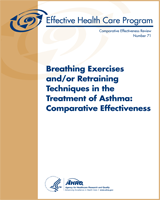This publication is provided for historical reference only and the information may be out of date.
Breathing Exercises and/or Retraining Techniques in the Treatment of Asthma: Comparative Effectiveness
Comparative Effectiveness Reviews, No. 71
Authors
Investigators: Elizabeth O’Connor, PhD, Carrie D Patnode, PhD, MPH, Brittany U Burda, MPH, David I Buckley, MD, MPH, and Evelyn P Whitlock, MD, MPH.Affiliations
Structured Abstract
Objectives:
To examine evidence for whether breathing exercises and retraining techniques lead to improvements in asthma symptoms, reductions in asthma medication use, improved quality of life, or improved pulmonary function in asthma sufferers.
Data Sources:
MEDLINE; PsycInfo; Embase; Cumulative Index to Nursing and Allied Health Literature; Physiotherapy Evidence Database; Cochrane Central Register of Controlled Trials; AltHealthWatch; Allied and Complementary Medicine; Manual, Alternative and Natural Therapy Index System; and Indian Medical Journals from 1990 through December 2011. Searches were supplemented with manual searching of reference lists and grey literature, including regulatory documents, conference abstracts, clinical trial registries, and Web sites of professional organizations.
Methods:
Analytic framework, Key Questions, and review protocol were developed with input from Key Informants and technical experts. Two independent reviewers screened identified abstracts against predefined inclusion/exclusion criteria. Two investigators reviewed full-text articles and independently quality-rated those meeting inclusion criteria. Data from fair-and good-quality trials were abstracted into standardized forms and checked by another investigator. We summarized data qualitatively and, where possible, used random effects meta-analysis.
Results:
We identified four types of interventions: hyperventilation reduction breathing techniques, yoga breathing techniques, inspiratory muscle training (IMT), and other nonhyperventilation reduction breathing techniques. We found the most robust body of evidence for hyperventilation reduction breathing techniques in adults, including the only large-scale trial (n=600, aged 14+). Hyperventilation reduction interventions (particularly those with 5 hours or more of patient contact) achieved medium to large improvements in asthma symptoms and reductions in reliever medication use of approximately 1.5 to 2.5 puffs per day, but did not improve pulmonary function. These trials also were more applicable to the U.S. setting than trials examining other interventions due to similarities in applicable treatment guidelines to U.S. guidelines and similar levels of development in the countries in which these studies were conducted, although applicability was still somewhat limited since none were conducted in the United States. Limited evidence suggested yoga breathing may improve pulmonary function in adults in addition to reducing asthma symptoms, but medication use was rarely reported and applicability to the United States was very low. Evidence for IMT and other breathing retraining techniques was limited to small, heterogeneous trials providing insufficient evidence to determine effectiveness. The only harms of breathing retraining techniques identified were minor annoyances associated with mouth-taping. Almost all trials were limited entirely or primarily to adults.
Conclusions:
Behavioral approaches that include hyperventilation reduction techniques can improve asthma symptoms or reduce reliever medication use over 6 to 12 months in adults with poorly controlled asthma and have no known harmful effects. However, available evidence is limited in its strength and applicability to the United States. Evidence supporting yoga breathing is weaker and applicability to the United States is very low.
Prepared for: Agency for Healthcare Research and Quality, U.S. Department of Health and Human Services1, Contract No. 290-2007-10057-I, Prepared by: Oregon Evidence-based Practice Center, Kaiser Permanente Center for Health Research, Portland, OR
Suggested citation:
O’Connor E, Patnode CD, Burda BU, Buckley DI, Whitlock EP. Breathing Exercises and/or Retraining Techniques in the Treatment of Asthma: Comparative Effectiveness. Comparative Effectiveness Review No. 71. (Prepared by the Oregon Evidence-based Practice Center under Contract No. 290-2007-10057-I.) AHRQ Publication No. 12-EHC092-EF. Rockville, MD: Agency for Healthcare Research and Quality. September 2012. www.effectivehealthcare.ahrq.gov/reports/final.cfm.
This report is based on research conducted by the Oregon Evidence-based Practice Center (EPC) under contract to the Agency for Healthcare Research and Quality (AHRQ), Rockville, MD (Contract No. 290-2007-10057-I). The findings and conclusions in this document are those of the authors, who are responsible for its contents; the findings and conclusions do not necessarily represent the views of AHRQ. Therefore, no statement in this report should be construed as an official position of AHRQ or of the U.S. Department of Health and Human Services.
The information in this report is intended to help health care decisionmakers—patients and clinicians, health system leaders, and policymakers, among others—make well-informed decisions and thereby improve the quality of health care services. This report is not intended to be a substitute for the application of clinical judgment. Anyone who makes decisions concerning the provision of clinical care should consider this report in the same way as any medical reference and in conjunction with all other pertinent information, i.e., in the context of available resources and circumstances presented by individual patients.
This report may be used, in whole or in part, as the basis for development of clinical practice guidelines and other quality enhancement tools, or as a basis for reimbursement and coverage policies. AHRQ or U.S. Department of Health and Human Services endorsement of such derivative products may not be stated or implied.
None of the investigators have any affiliations or financial involvement that conflict with the material presented in this report.
- 1
540 Gaither Road, Rockville, MD 20850; www
.ahrq.gov
